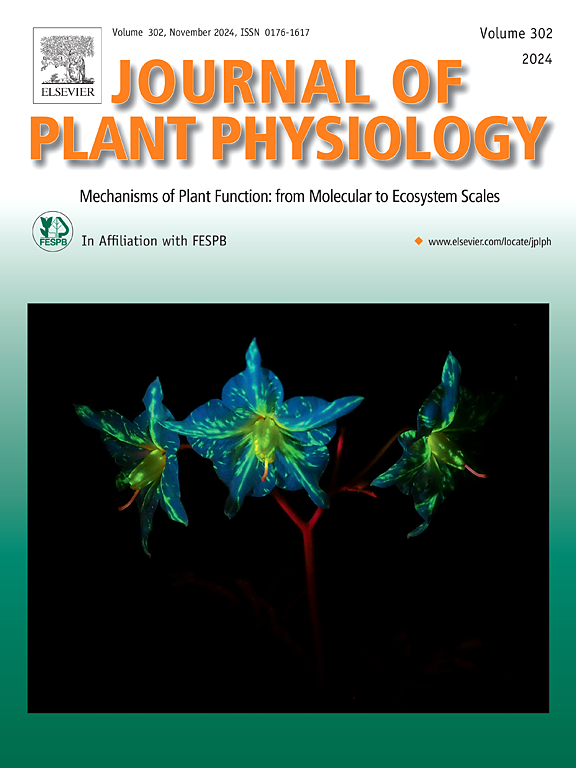Crosstalk of methylglyoxal and calcium signaling in maize (Zea mays L.) thermotolerance through methylglyoxal-scavenging system
IF 4
3区 生物学
Q1 PLANT SCIENCES
引用次数: 0
Abstract
Methylglyoxal (MG) and calcium ion (Ca2+) can increase multiple-stress tolerance including plant thermotolerance. However, whether crosstalk of MG and Ca2+ exists in the formation of maize thermotolerance and underlying mechanism still remain elusive. In this paper, maize seedlings were irrigated with MG and calcium chloride alone or in combination, and then exposed to heat stress (HS). The results manifested that, compared with the survival percentage (SP, 45.3%) of the control seedlings, the SP of MG and Ca2+ alone or in combination was increased to 72.4%, 74.2%, and 83.4% under HS conditions, indicating that Ca2+ and MG alone or in combination could upraise seedling thermotolerance. Also, the MG-upraised SP was separately weakened to 42.2%, 40.3%, 52.1%, and 39.4% by Ca2+ chelator (ethylene glycol tetraacetic acid, EGTA), plasma membrane Ca2+ channel blocker (lanthanum chloride, LaCl3), intracellular Ca2+ channel blocker (neomycin, NEC), and calmodulin (CaM) antagonist (trifluoperazine, TFP). However, significant effect of MG scavengers N-acetylcysteine (NAC) and aminoguanidine (AG) on Ca2+-induced thermotolerance was not observed. Similarly, an endogenous Ca2+ level in seedlings was increased by exogenous MG under non-HS and HS conditions, while exogenous Ca2+ had no significant effect on endogenous MG. These data implied that Ca2+ signaling, at least partly, mediated MG-upraised thermotolerance in maize seedlings. Moreover, the activity and gene expression of glyoxalase system (glyoxalase I, glyoxalase II, and glyoxalase III) and non-glyoxalase system (MG reductase, aldehyde reductase, aldo-keto reductase, and lactate dehydrogenase) were up-regulated to a certain extent by Ca2+ and MG alone in seedlings under non-HS and HS conditions. The up-regulated MG-scavenging system by MG was enhanced by Ca2+, while impaired by EGTA, LaCl3, NEC, or TFP. These data suggest that the crosstalk of MG and Ca2+ signaling in maize thermotolerance through MG-scavenging system. These findings provided a theoretical basis for breeding climate-resilient maize crop and developing smart agriculture.
甲基乙二酸和钙信号通过甲基乙二酸清除系统在玉米(Zea mays L.)耐热性中的相互作用
甲基乙二酸(MG)和钙离子(Ca2+)可以提高多种胁迫耐受性,包括植物的耐热性。然而,MG 和 Ca2+ 在玉米耐热性形成过程中是否存在相互影响及其内在机制仍未确定。本文对玉米幼苗单独或联合施用 MG 和氯化钙进行灌溉,然后将其置于热胁迫(HS)条件下。结果表明,在 HS 条件下,与对照幼苗的存活率(SP,45.3%)相比,单独或联合使用 MG 和 Ca2+ 的幼苗的存活率分别提高到 72.4%、74.2% 和 83.4%,表明单独或联合使用 Ca2+ 和 MG 可提高幼苗的耐热性。此外,Ca2+螯合剂(乙二醇四乙酸,EGTA)、质膜Ca2+通道阻断剂(氯化镧,LaCl3)、细胞内Ca2+通道阻断剂(新霉素,NEC)和钙调素(CaM)拮抗剂(三氟拉嗪,TFP)分别将MG提高的SP减弱至42.2%、40.3%、52.1%和39.4%。然而,未观察到 MG 清除剂 N- 乙酰半胱氨酸(NAC)和氨基胍(AG)对 Ca2+ 诱导的耐热性有明显影响。同样,在非恒温和恒温条件下,外源 MG 会提高幼苗的内源 Ca2+ 水平,而外源 Ca2+ 对内源 MG 没有显著影响。这些数据表明,Ca2+ 信号至少部分介导了 MG 提高玉米幼苗的耐热性。此外,在非恒温和恒温条件下,Ca2+和MG还能在一定程度上上调乙二醛酶系统(乙二醛酶Ⅰ、乙二醛酶Ⅱ和乙二醛酶Ⅲ)和非乙二醛酶系统(MG还原酶、醛还原酶、醛酮还原酶和乳酸脱氢酶)的活性和基因表达。MG 上调的 MG 清除系统在 Ca2+ 的作用下增强,而在 EGTA、LaCl3、NEC 或 TFP 的作用下减弱。这些数据表明,MG和Ca2+信号通过MG-清除系统在玉米耐热性中相互影响。这些发现为培育具有气候抗性的玉米作物和发展智能农业提供了理论依据。
本文章由计算机程序翻译,如有差异,请以英文原文为准。
求助全文
约1分钟内获得全文
求助全文
来源期刊

Journal of plant physiology
生物-植物科学
CiteScore
7.20
自引率
4.70%
发文量
196
审稿时长
32 days
期刊介绍:
The Journal of Plant Physiology is a broad-spectrum journal that welcomes high-quality submissions in all major areas of plant physiology, including plant biochemistry, functional biotechnology, computational and synthetic plant biology, growth and development, photosynthesis and respiration, transport and translocation, plant-microbe interactions, biotic and abiotic stress. Studies are welcome at all levels of integration ranging from molecules and cells to organisms and their environments and are expected to use state-of-the-art methodologies. Pure gene expression studies are not within the focus of our journal. To be considered for publication, papers must significantly contribute to the mechanistic understanding of physiological processes, and not be merely descriptive, or confirmatory of previous results. We encourage the submission of papers that explore the physiology of non-model as well as accepted model species and those that bridge basic and applied research. For instance, studies on agricultural plants that show new physiological mechanisms to improve agricultural efficiency are welcome. Studies performed under uncontrolled situations (e.g. field conditions) not providing mechanistic insight will not be considered for publication.
The Journal of Plant Physiology publishes several types of articles: Original Research Articles, Reviews, Perspectives Articles, and Short Communications. Reviews and Perspectives will be solicited by the Editors; unsolicited reviews are also welcome but only from authors with a strong track record in the field of the review. Original research papers comprise the majority of published contributions.
 求助内容:
求助内容: 应助结果提醒方式:
应助结果提醒方式:


